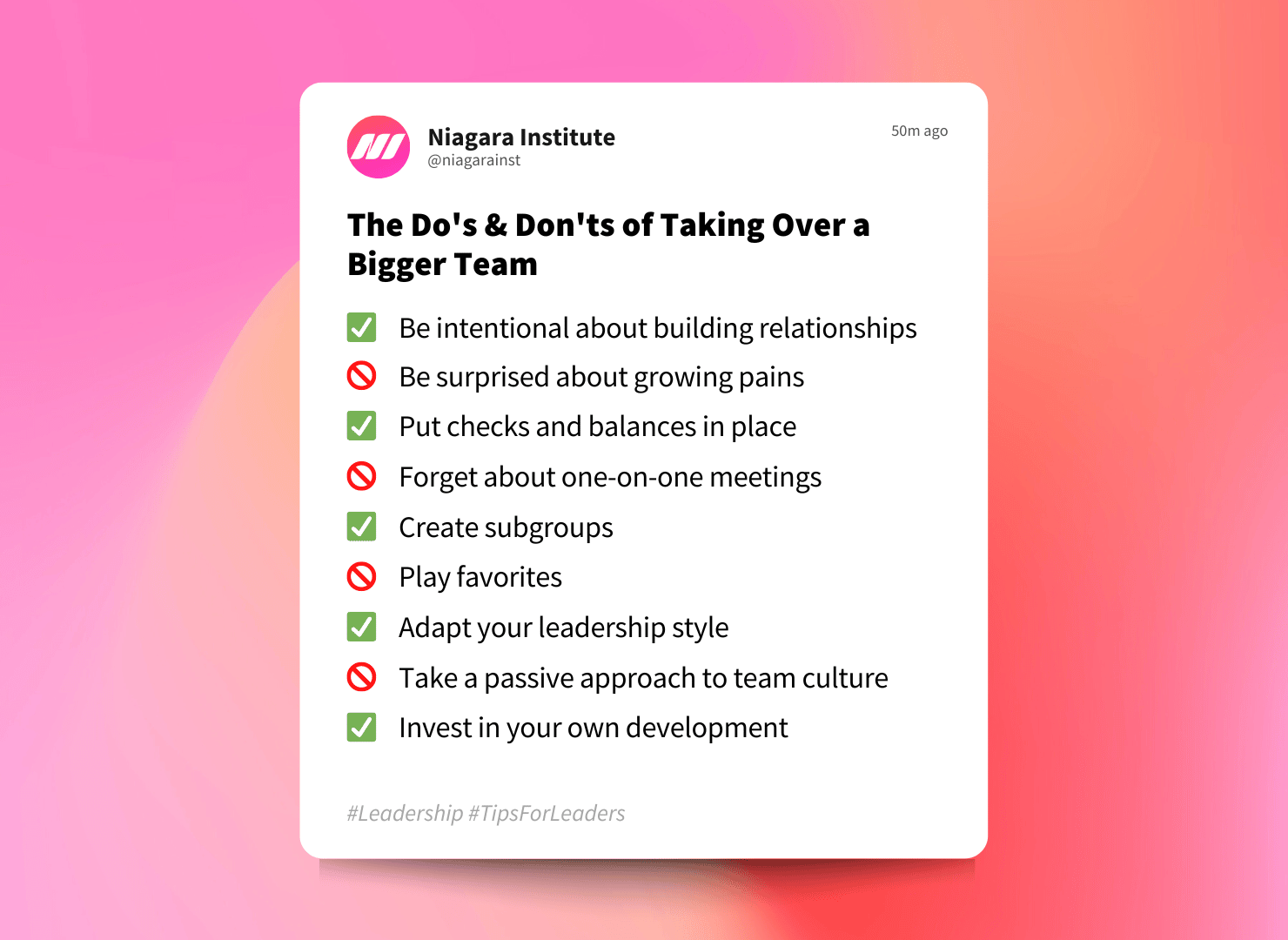5 min read
The Real Reason Direct Reports DON’T Have a Can-Do Attitude
There are some people who unintentionally and naturally exude a can-do attitude. They don’t shrink away from a challenge but rather face it head-on....
3 min read
 Michelle Bennett
:
Mar 16, 2023 5:00:00 AM
Michelle Bennett
:
Mar 16, 2023 5:00:00 AM

Taking over a bigger team is a significant transition for any leader. Inevitably, such a transition will present you with challenges you may never have had to handle leading a small team, such as forming cliques, competing priorities, and infighting.
If these types of things keep you up at night, then rest assured, you aren’t the first and won’t be the last leader to feel that way. Fortunately, there are things you can do that can make taking over a bigger team easier for you and your team. Moreover, there are things you should not do during the transition, all of which are discussed in more detail below.

As you transition to leading a bigger team, be intentional about connecting with each of your team members, getting to know them as people with lives and interests beyond work, and laying the foundation of a strong working relationship based on mutual trust and respect. As you do so, make a point to identify the unique strengths and abilities they possess that you can tap into to strengthen the team.
Taking over a bigger team means that there is less of you to go around. As a result, you won’t be able to keep as close an eye on everything going on as you might have before. Therefore, if you want to mitigate the number and severity of mistakes that might happen as a result, then you need to put checks and balances in place early on. In other words, create checklists, document processes, and set boundaries for your team to follow, and then update those as needed.
When taking over a larger team, you don’t get a say in how many people are on that team, which means that you could end up with a team bigger than what researchers consider the “ideal team size” of 3-6 people. In this case, you may want to consider creating subgroups within your team. Doing so would narrow the scope of focus and likely allow the subgroups to communicate and collaborate more freely and efficiently.
However, Atlassian points out that you must remember to “balance skills across the team, redefine established team interfaces, and carefully break down work duties. Otherwise, unexpected dependencies and potential new bottlenecks might occur and slow down delivery.”
While every leader has a dominant leadership style, when leading a bigger team, it becomes much more important to know how to adapt it according to the situation at hand and the people involved in it.
For example, you might have adopted the laissez-faire style when you were leading a smaller team because they were highly accountable and had proven themselves through a track record of success. However, when you take over a larger team that you are less familiar with, you may need to experiment with other styles of leadership until you find the right match for your new team.
When you begin leading a bigger team than you are used to, you will be presented with situations you have never had to deal with before that require new skills and tools. For this reason, it is crucial to invest in your own development as a leader during this transitional period. Whether you seek out the support of a mentor, tap into a professional coach, or attend a leadership training program, these development activities can give you the skills and tools you need to be successful in your new role.
As you begin leading a bigger team, there will be growing pains, mistakes, and teachable moments. Instead of downplaying or ignoring them, address them with your team. Show them humility and transparency by admitting you don’t have all the answers and are learning as you go. Doing so will go a long way in building their trust and gaining their respect.
Your weekly one-on-one check-in meetings with employees are one of the most beneficial uses of your time. However, those meetings can take up a large portion of your work week when leading a big team. While this might make it tempting to cancel or eliminate them altogether, this could be a costly mistake. Instead, make a point to create an agenda for your one-on-one meetings, send it out ahead of time, and set the expectation that your employees come prepared accordingly.
The fact is that we all “possess implicit biases, which wire our brain to categorize people and things subconsciously even when we actively try to reject prejudices” (Equiron). Unfortunately, this can cause you to play favorites even if you don’t consciously mean to. So, if you’re taking over a larger team that has employees who you already know or have worked with in the past, then you need to be especially careful not to demonstrate signs of favoritism, such as assigning desirable tasks to those people or giving them more praise than others.
If there’s one thing you should never take a hands-off approach to, it’s your team’s culture. That’s because your team culture has the potential to influence things like employee engagement, motivation, productivity, and turnover, for better or worse. So, when you step into a position leading a big team, you should start evaluating the current culture and begin to define the culture you want and what behaviors you need to develop or eliminate to obtain it.

5 min read
There are some people who unintentionally and naturally exude a can-do attitude. They don’t shrink away from a challenge but rather face it head-on....

4 min read
Culture. This term is thrown around about organizations. Ask someone about where they work and they’ll talk about the culture of the organization. ...

7 min read
Did you know that 52% of voluntary resignations are avoidable? As the Gallup study that found this states, “People leave because of fixable issues.”...